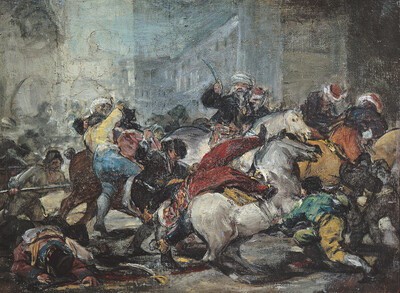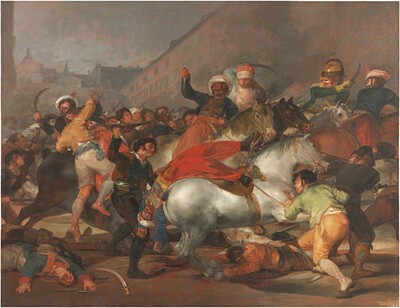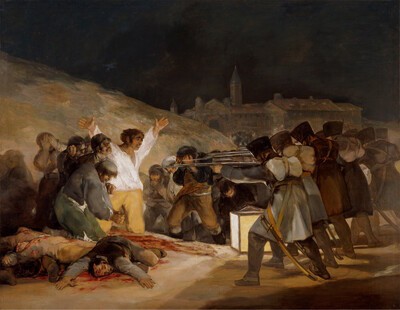- Cronología
- Ca. 1814
- Ubicación
- Museo Goya. Colección Ibercaja, Zaragoza, Spain
- Dimensiones
- 24 x 32 cm
- Técnica y soporte
- Oil on paper laid down on panel
- Reconocimiento de la autoría de Goya
- Documented work
- Titular
- Ibercaja Collection
- Ficha: realización/revisión
- 17 Mar 2010 / 14 Jun 2023
- Inventario
- (1174)
Goya (ángulo inferior izquierdo).
This is a sketch for the painting Second of May 1808. It has been known about since Yriarte mentioned it in his book on Goya. There is also a second surviving sketch for the same painting.
The work belonged to Valentín Carderera from Huesca, as indicated in the inventory of paintings in his collection, which mentions this original sketch by Goya in a gilded frame, valued at 1,200 reales de vellón (copper reales). On his death in 1880, it moved to the collection of the Duke and Duchess of Villahermosa, having first been installed in the Villahermosa Palace in Madrid and later in the Ducal Palace at Pedrola in Zaragoza. In March 1996 it was acquired for the Ibercaja Collection along with Masked Dance.
In this first sketch Goya focused on the figures in the foreground, leaving those of the middle ground and the buildings in the background very roughly sketched and in the shadows. The outlines are created with strong black marks, and the colours used are vivid, less toned down than in the definitive work. Some of the hues used here are also different. The blue trousers of the Valencian figure who leaps at the enemy's horse on the left-hand side of the composition is swapped for the white of the sash in the final version, making it less striking. The change means that the painter makes the red of the Mameluke's trousers the focus of the viewer's attention.
There are other alterations, such as the position of the head of the dead soldier on the left, which is portrayed in a much more gruesome way in the canvas, since he no longer wears a hat, and is placed with his face towards us so that we can see his lifeless face and his slit throat. The other changes made favour the realism and the stark brutality of the scene, meaning that the final piece is an impressive, shocking testimony, the poses and gestures of the figures made more furious and threatening.
The support is unusual, a way round the scarcity of materials - and in particular, canvas - suffered by the artist during the war years. Eighteen works on panel by Goya are preserved from this period, and some of these have been found to have underlying paintings. Goya also had to reuse canvasses to get by, as revealed by x-rays carried out of some pieces.
-
Goya 1900Ministerio de Instrucción Pública and Bellas ArtesMadrid1900consultant editors Aureliano de Beruete, Alejandro Ferrant, Marqués de Pidal and Ricardo Velázquez. May 1900cat. 74
-
Austellung. Francisco de GoyaGalería Paul CassirerBerlin1907
-
Pinturas de GoyaMuseo Nacional del PradoMadrid1928consultant editor Fernando Álvarez de Sotomayor. From Apri to -May 1928cat. 55
-
Exposición de bocetos para pinturas y esculturas (Siglos XVI-XIX)Sociedad Española de Amigos del ArteMadrid1949cat. 82
-
GoyaFestival Internacional de Granada, Palacio de Carlos VGranada1955consultant editor Enrique Lafuente Ferraricat. 110
-
Francisco de Goya. IV Centenario de la capitalidadorganized by Ayuntamiento de Madrid and Dirección General de Bellas Artes at the Casón del Buen RetiroMadrid1961consultant editor Valentín de Sambriciocat. II
-
GoyaKoninklijk Kabinet van Schilderijen MauritshuisThe Hauge1970organized by Ministerio de Estado y Asuntos Culturales and Réunion des Musées Nationaux, July 4th to September 13th 1970. Exhibited also at the Musée de l’Orangerie des Tuileries, Paris, October 25th to December 7th 1970, consultant editors Jeannine Baticle and A. B. de Vriescat. 44
-
Goya en las colecciones madrileñasMuseo Nacional del PradoMadrid1983consultant editor Enrique Lafuente Ferrari. From April 19th to June 20th 1983cat. 40
-
GoyaKoninklijke Musea Voor Schone Kunsten Van BelgiëBrussels1985consultant editor Luis González Seara. From October 26th to December 22nd 1985cat. 34
-
Realidad e imagen. Goya 1746 – 1828Museo de ZaragozaZaragoza1996consultant editor Federico Torralba Soriano. From October 3th to December 1st 1996cat. 59
-
De Goya al cambio de siglo (1800-1920). Pintura española y europea en la Colección IbercajaMuseu d’Art Jaume MoreraLérida2001organized by Obra social y cultural de Ibercaja at the following venues: Museo de Belas Artes da Coruña, A Coruña; Museo de Teruel; Museo de Huesca, Sala Amós Salvador de Logroño and Museo de Guadalajara, September 6th 2001 to March 10th 2002, consultant editor Ricardo Centellas Salamero.cat. 2
-
Goya e il Mondo ModernoPalazzo RealeMilan2010organized by SEACEX, Palazzo Reale and Fundación Goya en Aragón, consultant editors Valeriano Bozal and Concepción Lomba Serrano. From March 17th to June 27th 2010cat. 92
-
Goya, sa vie, son œuvreParísHenri Plon1867pp. 87, 136
-
L'œuvre peint de Goya. 4 volsParís1928-1950vol. I, p. 252, cat. 224
-
Vie et ouvre de Francisco de GoyaParísOffice du livre1970pp. 257, 267, cat. 983
-
BarcelonaPolígrafa1970vol. I, p. 359, cat. 621
-
L’opera pittorica completa di GoyaMilanRizzoli1974p. 127, cat. 563
-
Francisco de Goya, 4 vols.ZaragozaCaja de Ahorros de Zaragoza, Aragón y Rioja1980-1982vol. IV, p. 19
-
Un boceto poco conocido de Goya, preparatorio para El dos de mayo de 1808 en MadridGoyaMadrid1998
-
De Goya al cambio de siglo (1800-1920) : pintura española y europea en la Colección IbercajaLéridaIbercaja2001p. 46, cat. 2 y pp. 48-49 (il.)



